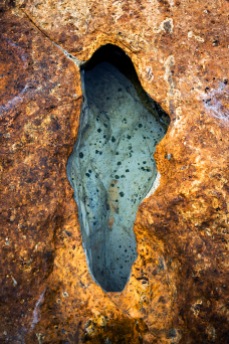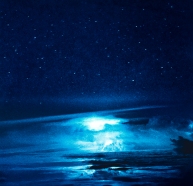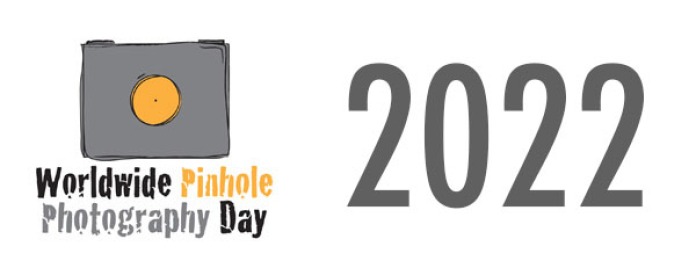Archive for the ‘Victoria Cooper’ Category
A Poem for Dad on ANZAC DAY – Victoria Cooper
.
My father Reg Cooper served in the Royal Australian Air Force in Papua New Guinea in World War II. During this time he made this work by collecting butterflies and placing them over a map of PNG and framing. It is entitled “Nadzab 1944” – where he was stationed.
Remembering small shared moments of joy for the natural world.
Many of which no longer exist but for a museum of memories.
With gratitude to my father
.
Pneumas
.
Flashes of colour
Flutter across the wall
The souls of the warriors
Fly over
The sublime terrain
While pinned
To a never ending present
.
Years pass
This man
Tends a distant garden
Preparing a fertile space
In anticipation for the end of dormancy
.
And so the decades
They fly
This man and a small child
Tend the garden
With humility in everyday work
Merging into a gentle rhythm
No expectations
Just joy in the flowers
That simply grow
.
But the Butterflies
Remain
Souls Hovering
Over that memory
What do they know
About Time…..
.
Eventually
The child alone
Tends the garden
Now a field
Rich with Dreams
Of Flowers
And Forests
.
All this …
For The Butterflies
To breathe
.
*Pneuma (πνεῦμα) is an ancient Greek word for “breath“, and in a religious context for “spirit” or “soul“.[1]
.
.
.
.
.
.
This Blogpost is copyright: Text – Victoria Cooper ©2020, Nadzab 1944 © Reg Cooper, Portrait of Victoria & Reginald Cooper – Helen Cooper ©circa1960
Any RSS reposting from this Blog without permission represents a breach of Copyright.
.
.
.
.
.
MARTIN HANSEN MEMORIAL ART AWARDS: Our Works
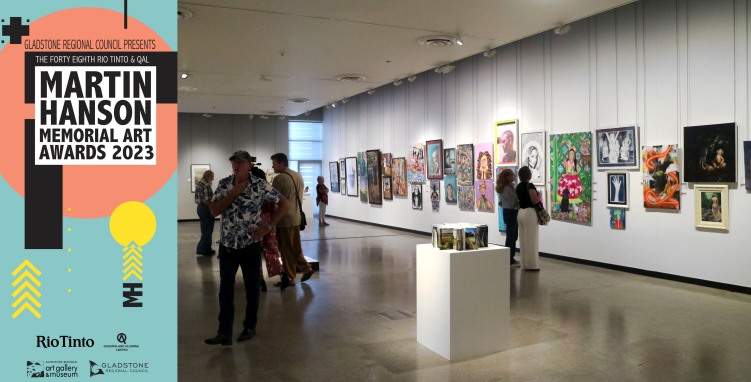
.
Once again we entered the Martin Hansen Memorial Art Awards at the Gladstone Regional Art Gallery and Museum. These Awards are the 48th event – Congratulations to the Gallery Team and the continued recognition of Martin Hanson’s early patronage of artists initiatives in Gladstone through these Awards.
For us each award entered is a place to present new works and their presentation – it is a challenge that hones our skills as artists.
.
This year Victoria’s entry was an artist book entitled String Theory Explained.
.

Victoria COOPER’s String Theory Explained presented
.Artist’s Statement:
String Theory Explained… its all about the unplanned and chaotic nature of everyday life… the beauty and terror within the order of “normal” existence.
.
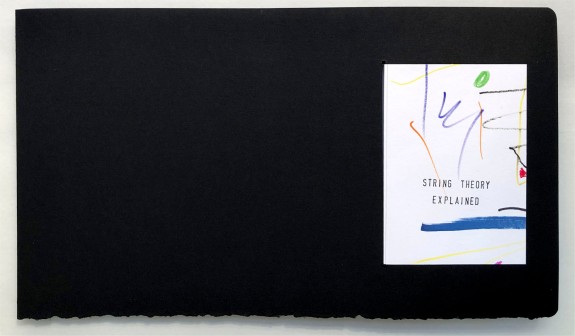
.
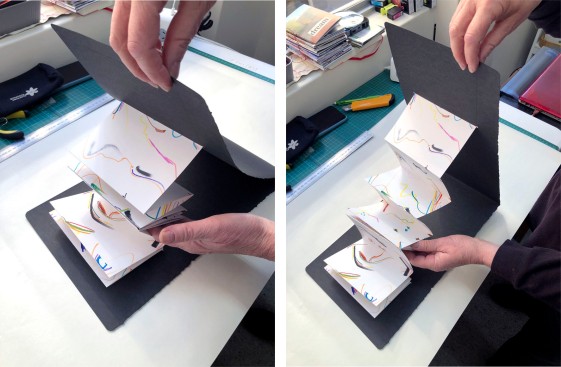
Opening up the book
.
Bibliographic Details:
Format: Concertina book embedded in folded cover
Media: various pen inks on art paper with Stonehenge black cover
Size: 764 x 230mm
.
.
Doug’s entry this year was Story Trees – First Nations a concertina artists book presented in a circular form.
.
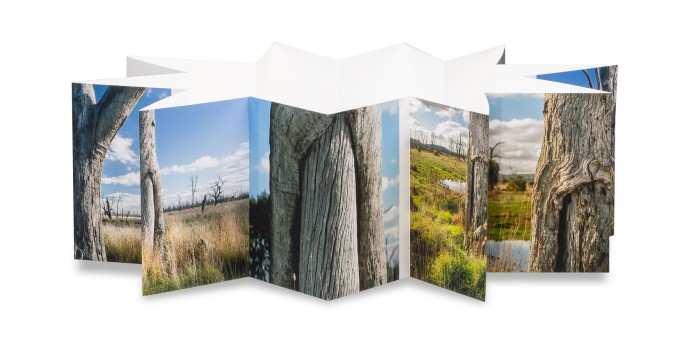
Doug SPOWART – Story Trees artists book
.
Artist’s Statement:
For me a poignant physical sign of First Nations presence remains embedded in the dead trees found throughout Mokoan. In witnessing these scar trees I found a profound sense of a time now passed and thoughts of the many stories that this place can tell.
This book was book two in a series of personal responses to encountering the locality of Mokoan and the Winton Wetlands. It was part of my contribution to the PALIMPSEST collaborative exhibition with Maggie Hollins and Victoria Cooper shown at Bainz Gallery in Wangaratta in August.
.
Bibliographic Details:
Format: Concertina book
Media: Pigment inks on photographic paper
Size in circular presentation: 600 x 700mm
.
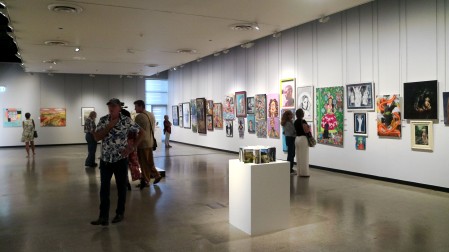
Doug’s Story Trees installed at GRAGM
.
.
The Martin Hansen Memorial Art Awards exhibition will be on show until 2.00pm on the 27th of January 2024 at the Gladstone Regional Art Gallery and Museum.
.
Here is some information about the 2023 Awards and the Entry Form.
.
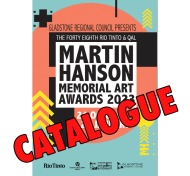 CLICK THIS LINK MH 23 Catalogue Online-r
CLICK THIS LINK MH 23 Catalogue Online-r
.
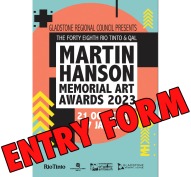 CLICK THIS LINK Martin Hansen Award 2023 Entry Details
CLICK THIS LINK Martin Hansen Award 2023 Entry Details
.
.
Photo of gallery installation courtesy of GRAGM
.
.
.
.
.
.
.
.
TONES OF HOME: Cooper+Spowart in group show
.
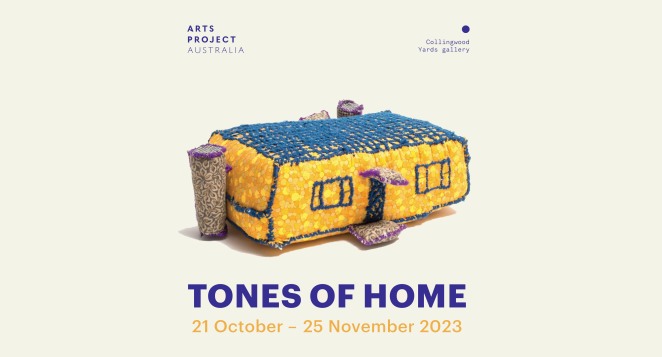
TONES OF HOME – Arts Project Australia
.
Tones of Home draws together artists from Arts Project Australia (APA), Melbourne, regional Victoria, and north Queensland to present works inspired by domestic and urban spaces. Curated by Eric Nash, Director Benalla Art Gallery the exhibition extends beyond these settings to consider ‘what makes a place, a home?’, touching on notions of family, community, belonging, connection, love, comfort, safety, and personal histories.
Featuring APA artists Steven Ajzenberg, Miles Howard-Wilks, Chris Mason, Chris O’Brien, Lisa Reid, Anthony Romagnano, Georgia Szmerling and Amani Tia alongside Atong Atem, Susie Buykx, Cooper+Spowart, Erub Arts Torres Strait and Ghost Net Collective, Aishah Kenton and Ron McBurnie.
(Text from the APA Website)
Tones of Home continues until 25 November 2023
.

Tones of Home Exhibition
.
SOME COMMENTS FROM THE CURATOR – ERIC NASH
The seeds of this exhibition were truly sewn at home. As my wife and I awaited the arrival of our second child, I found myself considering a work by Mini Graff that hangs above our bed. It is a street art poster in a vintage drawing style. Text on the work reads ‘Today is my lucky washing day’, and a woman hangs washing on a clothesline while an atomic bomb appears to have gone off in the background. It seemed to resonate with my experience of our domestic bubble of safety, and, when at home, perhaps even my ignorance to the outside world.This caused me to ponder what ‘home’ felt like, and indeed meant, to others? It had to mean more than just somewhere we reside. I couldn’t help but imagine my favourite fictional retired barrister, Lawrence Hammill QC, declaring, “You can acquire a house, but you can’t acquire a home”.
I owe a debt of gratitude to the Arts Project Australia team and artists who kicked this project off by sharing their thoughts on the topic of home. A number of responses stuck with me and have framed the exhibition. Home, in their words, could be “where the most important people in your life are”… “where you feel safe”… “a base where you start from”… “a place that fits your ideas of design,
location, and convenience.” Common themes emerged, specifically ‘Personal histories’; ‘Love and family’; ‘Community and connection’; and ‘Belonging, comfort and safety’. …READ MORE FROM THE CURATOR – Download the exhibition Catalogue
“CLICK LINK” TonesOfHomeCatalogue_Web
“CLICK LINK” “Tones-of-Home-Room-Sheet-2
..
SOME VIEWS OF THE EXHIBITION
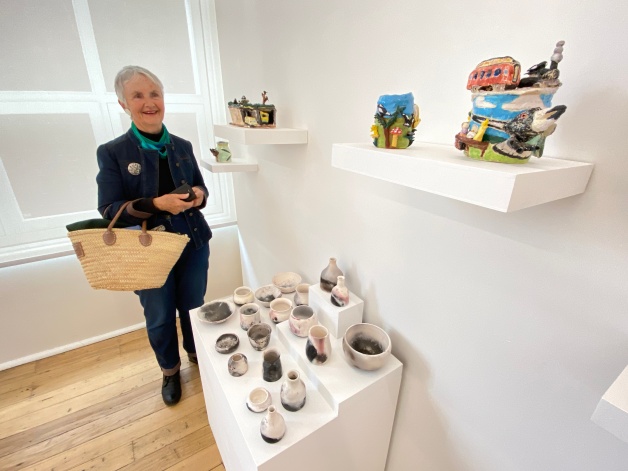
Susie Buykx and her ceramics
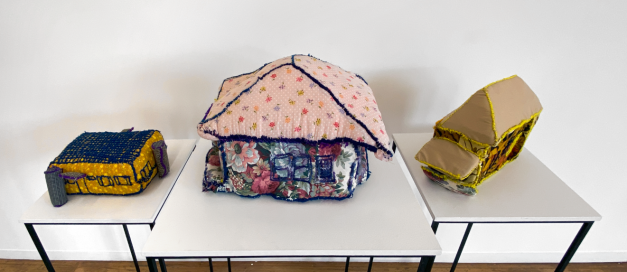
Chris O’Brien’s works
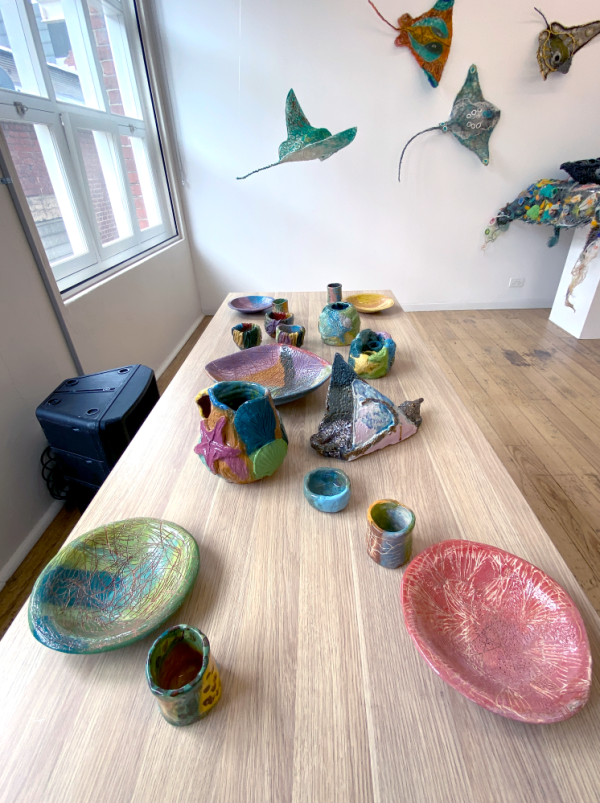
Georgia Szmerling ceramics (front) & Erub Arts Torres Strait and Ghost Net Collective (back wall)
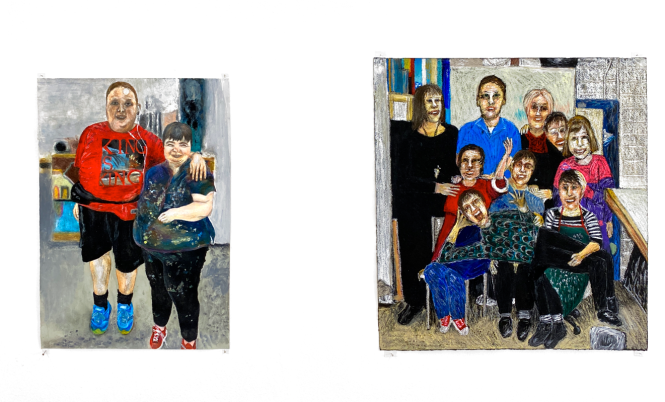
Chris Mason “Me and Monica Together” & “Me and my friends at work” 2019
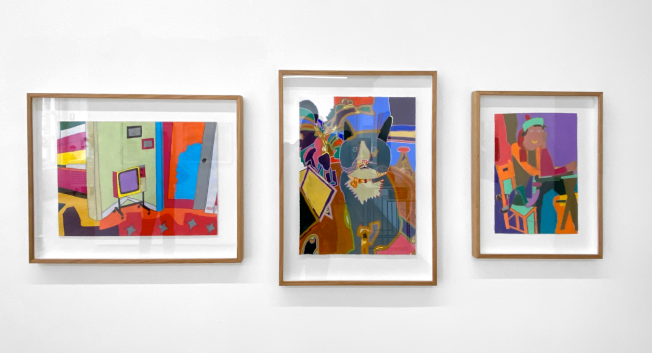
Anthony Romagnano’ works
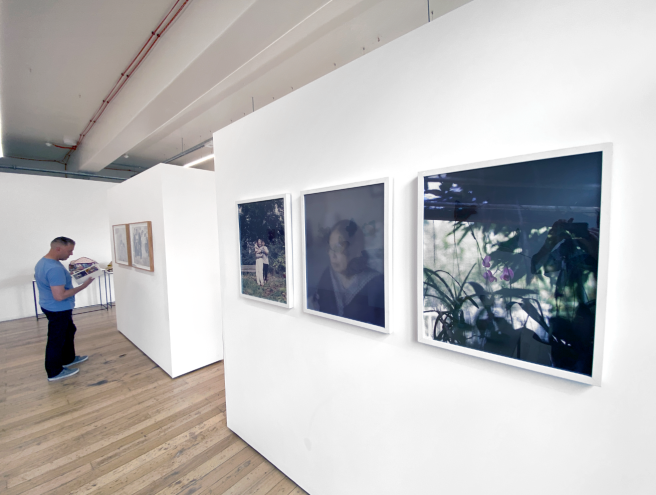
Aishah Kenton’s photographs
.
.
COOPER+SPOWART WORKS IN THE SHOW
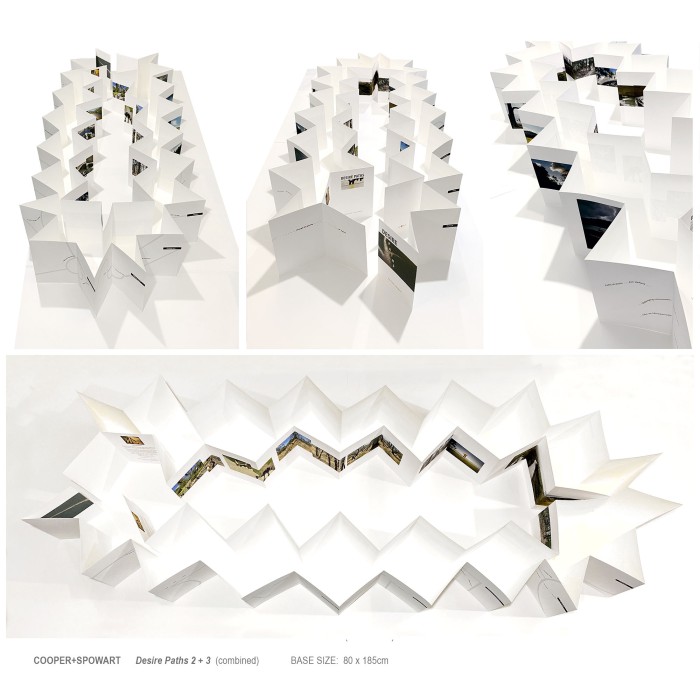
Cooper+Spowart “Desire Paths 2+3” Proposed layout
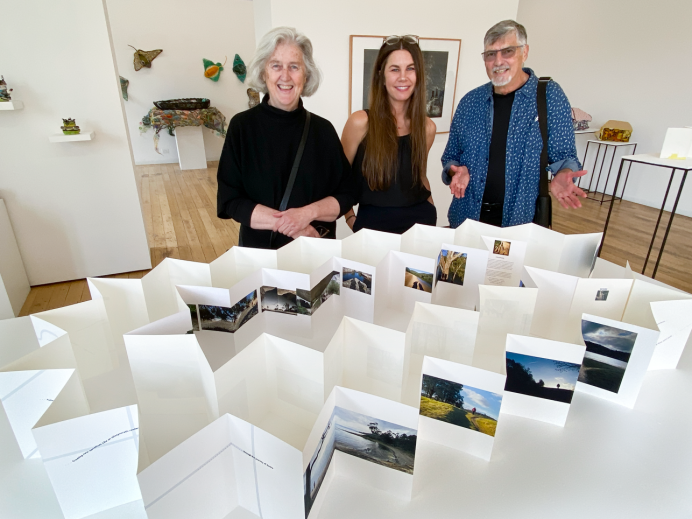
Victoria with Jo Salt Gallery Director + Doug PHOTO: Michael Coyne
C
COMMENTARY ON OUR DESIRE PATHS ARTISTS BOOKS…
Some words from Curator Eric Nash
… I write this essay now during paternity leave. This is the longest time I have spent consistently at home in years. This break and time with Tegan and our children brought something into clear focus: while Tegan and I have moved cities several times in the last ten years, I have always felt ‘at home’ as we have been together. Cooper and Spowart (Victoria Cooper and Doug Spowart) exemplify this through their extensive photography, photobook and artists book practices, which are maintained both as individual practitioners, and as life collaborators. For these artists, ‘home’ “was an idealised state of being in Place, which offered a sanctuary and a garden. More than architecture, ‘home’ is also a psychological and sensorial place for the safe shelter ofmemories and experiences.” (4)
Cooper and Spowart’s recent Desire Paths books resonate with their shared life and artistic journey, explaining “Our artistic process is also defined by the desire to discover new paths around the traditional norms. Over time these new paths become alternative solutions to the ultimate desired outcome. All these paths or lines are theexistential experience and representation of desire.” (5)
1.The astle (1997) Directed by Rob Sitch. [Feature .ilm]. Sydney, NSW, Australia: Roadshow Entertainment.
4 & 5. Cooper, V and Spowart, D (2023) Email to Eric Nash, 27 August.
.
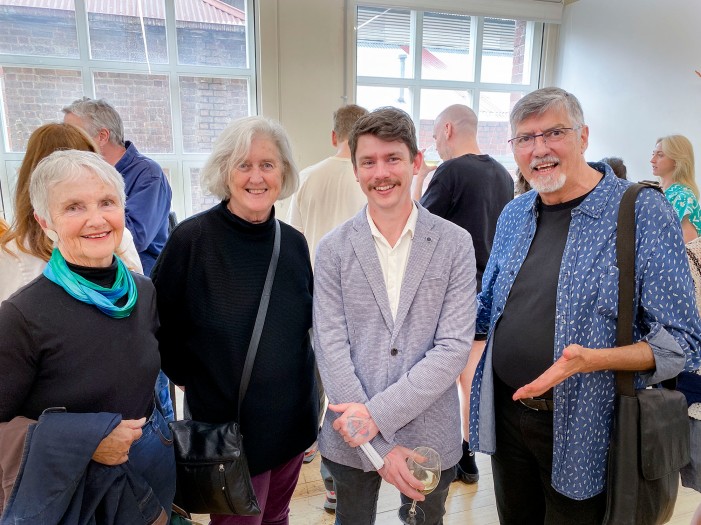
Susie Buykx+Victoria+Eric Nash (Curator) +Doug
.
Thanks to Eric Nash, Jo Salt and the Team at Arts Project Australia for the opportunity to to show work in this exhibition in Melbourne (Naarm). N
.
.
.
Unless noted otherwise photographs are by Doug Spowart
.
.ash
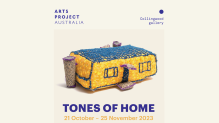
.
.
.
.
.
.
IN THE WETLANDS: 3 Artists – Cooper + Hollins + Spowart collaborate, drawing inspiration from Winton Wetlands
.
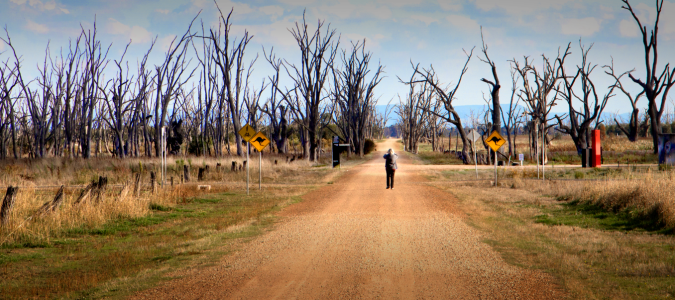
PALIMPSEST Exhibition artists in Winton Wetlands
.
The Winton Wetlands in north-eastern Victoria, also once known as Lake Mokoan, has been through many changes from farming to the building then decommissioning of a dam. Now this visually haunting and beautiful place is undergoing a new phase of regeneration – reviving the natural state of living wetland environment.
.
Dr Lisa Farnsworth, Winton Wetlands Restoration Manager, has been working with local artists to form a group that finds inspiration for their art in the Wetlands. She comments:
.
The Winton Wetlands Creatives Group is driven by a passion for the natural beauty and cultural richness of the Winton Wetlands Reserve. Through various art mediums and engagement opportunities, the group aims to advocate for the Winton Wetlands restoration project and for the ongoing protection and appreciation of its cultural and ecological assets. I’m genuinely excited to see how art, culture and ecology can align to create great outcomes for the health of our local people and natural landscapes.
.
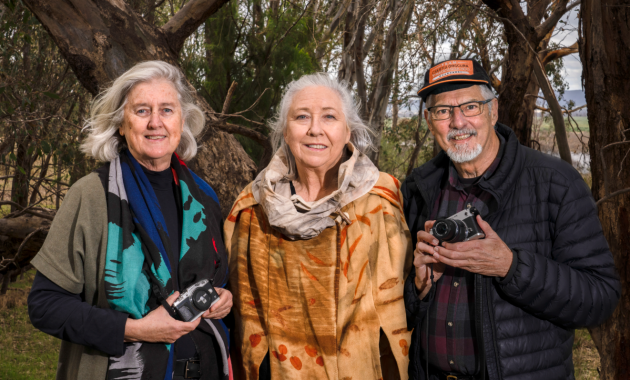
Artists Victoria Cooper, Maggie Hollins + Doug Spowart
.
In the spirit of Lisa’s vision we formed a collaboration with fellow Benalla artist Maggie Hollins to create a visual response to the Winton Wetlands inspired by its layered human and natural history and contemporary renewal. In our work we have associated this altered landscape with the concept of a palimpsest – a manuscript that was reused by writing new text over the previous words.
.
The Palimpsest features again in the exhibition where the collaboration between us as artists can be experienced as a layered narrative, where multiple stories and experiences intertwine to form a cohesive whole.
.
Check out our INSTAGRAM Project picture trail https://www.instagram.com/wetlands.palimpsest/
.
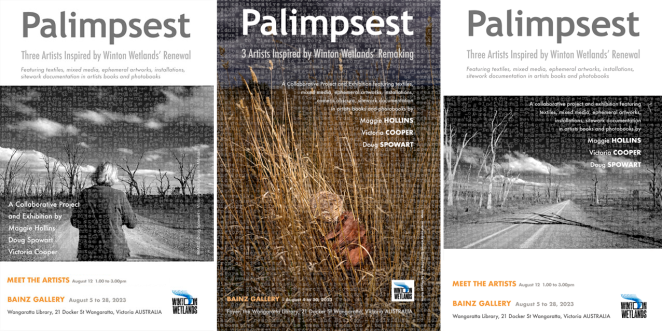
3 Invitations for the exhibition in BAINZ GALLERY in Wangaratta
.
.
SOME VIEWS OF THE EXHIBITION
.
.
SEE A FLY-THROUGH VIDEO OF THE EXHIBITION
.
.
.
A COMMENTARY ON THE EXHIBITION …
Victoria Cooper, Maggie Hollins and Doug Spowart have collaborated to produce and display a wonderful and diverse visual exhibition. They have sought to associate the altered Winton Wetlands landscape with the concept of a palimpsest. In doing so they are contributing to discussion of different, yet overlapping, stories of the wetlands.
Cooper and Spowart have been involved in the arts as practitioners, teachers and commentators for a lengthy time, including having residencies at Bundanon. Hollins has qualifications in ceramics, leads art workshops and enjoys playing fiddle. Unsurprisingly therefore, each and every artwork displayed is of a high standard.
There are unique, handmade textural and sculptural artworks by Hollins that use a diverse variety of materials – including found small branches, knotted bark, dyed cotton thread, solar and rust dyed cotton fabric, metal rings, and found grasses. They are accompanied by postcard sized images of the same artworks “displayed” on site in the wetlands. Those images were a team effort – Hollins operated the camera, Cooper was location scout and camera assistant, and Spowart did the lighting and Director of Photography duties.
There are larger standalone photographic prints and collaborative diptychs by Cooper & Spowart conveying stories of witnessing, magnificent 3 metre wide concertina photobooks by Spowart displayed folded out and attached to the wall, plus artist books and poetry by Cooper.
It all comes together splendidly, successfully conveying the messages the artists want visitors to hear.
.
BRIAN ROPE Reviewer for and member of the Canberra Critics Circle
Read Brian Rope’s full review HERE
.
.
LATER POSTS WILL FEATURE MORE ABOUT THE INDIVIDUAL ARTISTS & THEIR WORKS …
.
.
.
SEE MORE ABOUT THE WINTON WETLANDS …
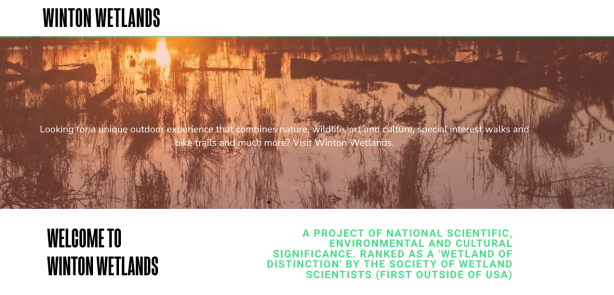
Winton Wetlands website Home page
CLICK HERE FOR THE WINTON WETLAND’S WEBSITE
.
.
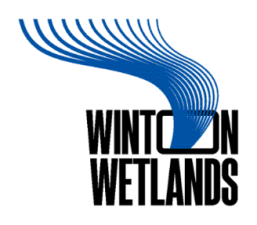
Winton Wetlands logo
.
ACKNOWLEDGEMENTS
The artists wish to acknowledge the Winton Wetlands team for their support.
We acknowledge the traditional lands of the Yorta Yorta people & their 8 clans the original owners of Country.
We respect their deep enduring connection to their lands and waterways and recognise that sovereignty was never ceded.
We honour and respect their ancestors, their Elders past, present and emerging.
.
.
.
.
.
NICHOLAS WALTON-HEALEY – SALT FRAMES
.
.
A SELECTION OF IMAGES
.

‘SPOOR’ Nicholas Walton-Healey from the exhibition SALT FRAMES

‘WHISPER’ by Nicholas Walton-Healey from the exhibition SALT FRAMES

‘SKIN’ Nicholas Walton-Healey from the exhibition SALT FRAMES

‘TOUNGE’ Nicholas Walton-Healey from the exhibition SALT FRAMES

‘CARESS’ Nicholas Walton-Healey from the exhibition SALT FRAMES
.
A COMMENTARY ON THE BODY OF WORK by Victoria Cooper
.
watch the water long enough and you’ll see a fish jump … *
.
Salt Frames review
Nicholas is a poet…
Salt Frames is simultaneously a visual and textual poem. On the surface it is an exhibition of light and colour abstractions from time spent on the Nightcliff Foreshore, Darwin. But this work also has deeper layers and meaning that are evoked through the supporting words and symbols within the images, as Walton-Healey discloses: “Sea salt aids the healing of wounds (including those beneath the surface of the skin).”
Walton-Healey points out that more broadly Australians have an affinity to the coast. The sea and the coast become places of personal meditation and for some physical and psychological healing. His seascapes are not the usual pictorial or grand panorama – instead he shares visual metaphors; those moments of revelation and contemplation that can hold many different meanings to the viewer.
The text blocks with the images are, for me, not titles but words that operate as codes to other ways of being and thinking. If we cast our minds to memories of reverie by the sea, perhaps these words articulate our collective human experience of being at the coast.
On connecting with Walton-Healey’s opening speech, the meaning embedded in the words and the images of layered light, colour and stilled moments was underpinned by a deeply moving human story. Through the visual poetry of this exhibition the artist has humbly shared vulnerability, tenderness and deep thinking. In this openness of vision he also created space for the viewer to spend time to consider and connect with our own stories and memories.
.
Dr Victoria Cooper
* A teaching by Larrakia Warrior Robert E. Lewis to Nicholas Walton-Healey
.
.
THE OPENING SPEECH BY PAMELA KLEEMANN-PASSI

Pamela Kleeman-Passi speaks
.
Acknowledgement to Country
We respectfully acknowledge the Traditional Owners of the land, the Boon Wurrung and Woiwurrung (Wurundjeri) peoples of the Kulin Nation. We extend gratitude to all Elders past and present and their enduring connection to land, sea and community.
.
.
Welcome to the Salt Frames exhibition …
.
My friendship with Nick grew out of a deeply personal connection of loss and renewal, and a mutual passion for experiencing life through the lens of creativity. And now we have Darwin in common! Our shared stories meandered and overlapped during my month there mid-last year for my own exhibition. I actually didn’t know that much about Darwin until that visit, and I returned to Melbourne with a deep fondness for the culture, the landscape and the communities. I thank Nick for facilitating a visit to the Tiwi Islands to spend a moment of precious, rejuvenating time at the Tarntipi Bush Camp on Bathurst Island.
.
So what you see within these salt frames of the Nightcliff foreshore is Nick’s immersion in and introspection on the blessings and cruelties of life, and the healing power of the water and the land. The evocative single word titles express an array of feelings and experiences and the images are imbued with opposites:
Landscape / seascape Water / land Surface / depth
Smoothness / crusty, gritty textures Clarity / blurriness Light / dark
Shadows / highlights Colour / monochrome Reflection / absorption
Representation / abstraction Emotion / rationale
He’s combined the poetic and the photographic, with an Impressionist painterly quality to many of the works. Nightcliff is a very special place for Nick… but it also has a fascinating history and I quote from Tess Lea’s personal/historical book, Darwin: “Even the dumping grounds of Nightcliff, where unwanted machinery and detritus from WWII were tipped over a cliff, have merged into the rocks below, no longer distinguishable, just deformed lumps of rust and chalk.” The colour of rusted metal is very evident within some of the images – how over time, it’s merged with the landscape shaped by the power of the sea.
In this time of climate fragility and significant settler land and sea degradation, I feel compelled to refer to ecological grief and the healing power of the land and the water because the land and sea are absolutely fundamental to a community’s overall mental health. Nick’s images are testament to that healing power.
For Nick…
On the edge, at the edge… of love and loss and longing,
And remembering and wanting to forget
And letting go but holding on…
Wedged between land and water, pushing and pulling
Lapping across a surface that belies a depth so utterly profound and unfathomable
A photographic imprint, focused and blurred
Where light inscribes water, water inscribes land
And language and form mutate and merge, rippling and surging in a constant soundtrack
That violently crashes and gently caresses in waves and heartbeats
Eroding, erasing, healing and repairing
The run-off leaving traces that ebb and flow
As life and love and loss and longing ebb and flow…
And it’s sink or swim or scramble to a fragile stability on solid ground and remain upright
or undone
Or both…
.
.
Pamela Kleemann-Passi © 2023
.
.
ROBERT LEWIS TALKS ABOUT HIS CONNECTION WITH NICK

Robert Lewis, Larrakia Warrior, speaks at the opening of SALT FRAMES
.
Nic from Vic
Hi my name is Robbie Lewis, I’m a Larrakia Man. Born and bred on Larrakia land in Darwin.
2013, The Eye See Workshop, working with young Indigenous people living on a local community, in the Darwin region, where I met a young man trying to make understanding of life, this is when I first met a young spirited man, Nicholas Walton-Healey!!
.
A student photographer trying to find he’s way around the community. At first, I saw another white man taking photos of Indigenous people. But now, 10 years later, I see a great man showing the rest of the world through he’s eyes the beautiful things he sees through a camera.
To talk about
Communications – to talk, to say, to hear, to listen, to answer, to reply, also to understand and help.
Management – to be a leader, a teacher, to educate, to be in charge, to manage and help.
Worker – to do a job, to earn a wage, to keep things moving forward, to do work and to help where there is no other.
Just don’t forget why they go together.
The Student
This one person brings all these people together.
Now I see this man as a teacher!!
.
Robert Lewis © 2023
.
.
NICK’S RESPONSE

Nick addresses the audience at his exhibition
.
Thank you everyone for making it out tonight. I don’t have the time to personally thank each one of you, here. But I’m really proud of, and humbled by, the diversity of the groups represented in this room. Friends. Family. Collaborators. Colleges. Mentors. And Muses. You’ve all contributed in some important way to the journey I’ve been on, with my photography.
Pam and Rob, I’m especially grateful for the friendship I share with each of you, and for your very kind and thoughtful words tonight.
.
What you’re looking-at in the salt frames photographs, is The Timor Sea. And more people go missing each year in The Timor Sea, than they do in any other sea throughout the world.
I can certainly say that I’ve felt the pull. The allure of its rhythm, and hypnotic calamity.
It made perfect sense to me, when I read that statement in a book that Pam recently lent to me. Over the past twelve months, Pam has gifted me some important inspiration – we met at the ANAT Spectra Live event in Melbourne, and our paths crossed again in The Northern Territory last year. They converged at Tactile Arts in Darwin, during Sweet Dreams and Gut Reactions, the title of Pam’s exhibition, which got me thinking…
It’s probably an understatement, for those of you who know me, to say I’m inspired by the viscerality of art. I’ve always understood the role of the artist to entail a questioning of accepted definitions of the normal and possible. And that the moral and aesthetic responsibility of the photographer is to make the invisible, visible and the familiar, strange…
Photography is a highly intuitive process for me. I make the pictures first, and make-sense of them, second. So, I wasn’t exactly sure what I was doing, walking up and down the Nightcliff foreshore at all hours of day and night, last year.
I was actually stopped one evening by an elderly couple, who said ‘ahh, you’re a photographer!?’ I looked-at them, bemused, because I had a camera in my hand, and responded with, ‘yeah!’ But then the lady then came closer, and touched me on the arm. She looked into my eyes and said, ‘Well, that’s good, because we’ve seen you out here every night this week and thought you were homeless.’
The remark startled me because, while I was always on the lookout for crocs, I actually felt pretty safe in Darwin last year, which was when I made the majority of these photographs. Even if I was sleeping on a mattress on the floor of Rob’s kitchen.
I have a really special connection with Rob, who is like a big brother, to me; one of my mentors, teachers, guides and best mates, over the past ten years.
I first met Rob on an Indigenous community known and referred to in Darwin as Knuckey’s. This was back in 2013, when I first travelled-up to Darwin with one of my university lectures – Mark Galer – for The Eye See Workshop. Although our initial encounters were brief, I remember being struck by the enormity of Rob’s heart; the fact that he actually, genuinely cared for the people living on this, and the other communities we visited.
At the end of that workshop, I was invited back to Darwin by Rob’s boss-at-the-time. From this point, I entered into what became a five-year-plus partnership. This lead me back out onto those communities, and ultimately, to almost all of the so-called town camps in and around the Greater Darwin Region.
For all this time, I was like Rob’s little shadow. I followed him everywhere, and especially to the programs he ran with the men and family groups from these communities. Through these means, I built my own friendships and connections. But that’s another story, another project…
The Salt Frames are more overly focussed on my personal connection with Rob. Our friendship grew partly through the bond I developed with his late mother, Robyn, who I learnt to recognise and identify as an authentically Darwin person; Robyn’s mother (Rob’s maternal grandmother), was born at Lamaroo Beach, before being stolen as a child, and was eventually adopted by Juma Fejo.
The Fejos are one of the original eight family groups recognised as the Traditional Custodians of the Greater Darwin Region.
So Rob’s Larrakia, and the Larrakia are also known as The Salt Water People. The Salt Frames show Larrakia country, which includes Nightcliff, the place where Rob and I spent a lot our time when we weren’t working on the communities together.
Watch the water long enough and you’ll see a fish jump. That’s what Rob used to say to me. And I found it really frustrating at first, because I couldn’t see any fish. But over time, I realised that, rather than asking me to simply look-at the water, Rob was actually asking me to look into it. In this way, he transformed my ability to ‘see.’
But he wasn’t the only person I went to Nightcliff beach with. Before and after re-locating from Melbourne to Darwin, Nightcliff was the place that my late fiancé most liked to visit. She loved watching the sunsets. And unwinding and connecting on the beach. Over the years, we made a lot of love along this coastline. Beside the Timor Sea. And sure enough, it was not too far up from one of these spots that we returned on the afternoon she received her cancer diagnosis.
Shit happens. We deal with it. And then we move-on. That’s also one of Rob’s sayings; but it was the teaching I found most difficult to comprehend. Dealing with it, was what I really trying to do in the five and half months I spent in The Territory last year, walking around the beach like a homeless person.
Making these photographs was one way I felt I could make-good on my promise to do something with my photography, while at the same-time maintaining the connection that my finance and I shared with the families and communities we worked with. In August last year, Rob accompanied my mother and I over to the Tiwi Islands, for her Pukamani ceremony. The overwhelming majority of the photographs in this collection were made in the weeks that followed this event.
So whichever way you look at them, the Salt Frames show profound and enduring connection. But they also acknowledge the inescapably transient nature of being. You don’t get to beauty without pain, and love is very hard to name, without seeing the full-face of loss. The process of curating and assembling this show, and gathering you all in this room tonight, is part of an attempt to move forward.
..
Thank you all … Nicholas Walton-Healey
Nicholas Walton-Healey © 2023
.
.

Nicholas with Pam Kleemann-Passi and Robert Lewis
.
.
.
.
.
.
© Photographs by Nicholas Walton-Healey Photographs of the opening ©2023 Doug Spowart
WORLD CYANOTYPE DAY 2022: ANZ – Online Exhibition
 .
.
EACH YEAR FOR THE LAST 4 YEARS WE HAVE COORDINATED AN EXHIBITION OF ARTWORKS BY AUSTRALIAN CYANOTYPE PRINTMAKERS TO CELEBRATE INTERNATIONAL EVENTS LINKED TO WORLD CYANOTYPE DAY.
Unlike most years where the exhibition is in a physical gallery this year the exhibition is an online catalogue. Another aspect of World Cyanotype Day (WCD) events is the connection that works made should respond to a theme which this year was – ENLIGHTEN. This year WCD falls on Saturday September 24th.
Our preparations for the exhibition began back in May with a call for expressions of interest from members of the Facebook Group The Cyanotype in Australia and New Zealand – A group we founded in 2019 to facilitate the first WCD exhibition at the Monash Gallery of Art.
Respondents were presented with the concept of “presenting your cyanotype in a way that shows something about you – It could be positioned in your studio, home setting, in the garden or somewhere in your locality”.
Twenty-five cyanotype makers sent in their submissions. These artworks were collated and prepared for the design stage of the project by us. Here are their cyanotypes and a link to download the catalogue. ALSO at the end of the post is the story and links to the previous year”s catalogues.
.
Here the submissions:
“CLICK” on the thumbnail to enlarge the image and see the author’s name and title
THE ONLINE CATALOGUE IS AVAILABLE TO DOWNLOAD –
Here is the file: CYANOTYPE CATALOGUE 2022v3
Here is the backstory the 5 Cyanotype in Australia and New Zealand WORLD CYANOTYPE DAY exhibitions & catalogues
 Download: WCD_CinA-Catalogue-2018
Download: WCD_CinA-Catalogue-2018
Event 1 – 2018
In September 2018 The Cyanotype in Australia Facebook group was founded and held its first collective exhibition and illustrated catalogue as part as the global event World Cyanotype Day (WCD). Entitled In Anna’s Garden the exhibition referenced Anna Atkins’ pioneering role in the development of the cyanotype.
The exhibition was held in the Atrium Space at Monash Gallery of Art, Wheeler’s Hill, Melbourne and was opened by Gael E Phillips. Gallery staff members Stephanie Richter and Gillian Jones joined with Victoria Cooper and Doug Spowart to prepare and hang the diverse representation of Australian contemporary cyanotype work. The Gallery Director Anouska Phizacklea attended the event along with many of the exhibitors.
 Download: WCD_CinA-catalogue-2019
Download: WCD_CinA-catalogue-2019
Event 2 – 2019
A world-wide call out from the A. Smith Gallery in Texas, USA, invited artists to participate in an exhibition by sending a cyanotype made on a 30cm square of fabric – referred to as ‘Flags’. The work was a personal response to the WCD theme for that year, Land / Sea / Sky.
The Cyanotype in Australia (CinA) co-ordinators decided to organize a collaborative show of cyanotype flags connecting with the WCD. Coordinated at the Maud Street Photo Gallery in Brisbane, the exhibition was called Under the Southern Sun. Again, the coordinators were supported by Gail Neumann, David Symons and Keiko Goto in the unpacking and hanging the flags in the gallery. However this was only the first part of a long and exciting journey for these cyanotype prints.
After the show came down, the working party packed up the show and the Flags were sent off to Texas where they were shown with all the other works from across the world at the A. Smith Gallery. Subsequently the exhibition was also shown at PhotoNOLA in New Orleans.
 Download: ____WCD 2020 CATALOGUE-FINALv3
Download: ____WCD 2020 CATALOGUE-FINALv3
Event 3 – 2020
Due to the pandemic 2020 was a difficult year to show work in a physical gallery space so the CinA co-ordinators created an online presence and an illustrated catalogue referencing the WCD theme of Interconnected. After a call out to all members of our Facebook group, artists from across Australia and around the world responded by contributing to the collection of a creative work that showcased the diverse practice of the cyanotype in Australia and elsewhere.
 Download: WCD 2021 Exhibition-SCREEN_Res-Sept27
Download: WCD 2021 Exhibition-SCREEN_Res-Sept27
Event 4 – 2021
Despite the challenges of Covid, 2021 saw the return of a physical exhibition. Gail Neumann curated the show at KEPK Gallery in Brisbane, supported by other members of the CinA team. The WCD theme this year was REJUVENATION. Local art identity and cyanotyper LeAnne Vincent opened the exhibition and an illustrated catalogue was made available to participants.
Event 5 – 2022
For many surviving Covid, floods and fire and rebuilding their arts practice has been challenging over the last 2-3 years, so the return to an online format seemed a good option. Also at this time, the organisers felt that it was important to recognize our friends and colleagues from across “the ditch” in New Zealand, so our group name was changed to The Cyanotype in Australia and New Zealand.
The call for expressions of interest was made in May and those who responded were asked to submit work on the WCD theme – ENLIGHTEN. They were also requested to consider making an in-situ representation of their cyanotype image in their studio space or where they live, to add a personal and physical dimension to the virtual online space. The 2022 catalogue includes the artists who responded to the in-situ request, and also those who only sent through a photograph of their cyanotype.
Once again, the catalogue presents a survey of the practice of cyanotype within our region. We wish to thank the contributors for making work available for this catalogue as well as providing commentaries about their work.
ENJOY and be ENLIGHTENED about the work by the members of the Cyanotype in Australia and New Zealand.
.
.
ABOUT THE CYANOTYPE IN AUSTRALIA + NEW ZEALAND
The Cyanotype in Australia + New Zealand Facebook group has actively supported a vibrant community of practice of not only local, but also international cyanotypers for 5 yearsFF.
The Facebook page is a closed group though we welcome ‘Requests to join’ from cyanotype practitioners of this region.
The Cyanotype in Australia+New Zealand Team are Doug Spowart, Gail Neumann, David Symons and Victoria Cooper.
.

.B
.
.
MGA POSTCARDS EXHIBITION – Our images
.
WE RECENTLY RESPONDED TO A ‘CALL OUT’ FROM THE MONASH GALLERY OF ART to make and send in a POSTCARD representing ‘Our back yard’.
It is an interesting Mail Art Project so we selected images and sent them in. Recently we are in Melbourne and managed to go out to MCA to see their exhibitions and the post card show in the Atrium Gallery.
.
If you are interested in participating – The details and link are at the end of this post.
VICTORIA’s CARD: Image from the book VISUAL FIELD NOTES

Victoria Cooper MGA POSTCARD
.
ABOUT VICKY’S POST CARD IMAGE: DAY DREAMING
We arrived in Benalla during one of the long Covid 19 lockdowns of Victoria. We found ourselves under a state wide travel restriction of only 5kms from our home. So walking became my way of exploring my new locality.
On these walks, and later on longer journeys,
I was captivated by the remnants of natural environment at the edge of the suburban spaces, roadsides and bushland. Here in the North East the trees tower like epic monuments to a pre-colonial history …
DOUG’s CARD:
An image from the book WALKING URBAN GROUND

Doug Spowart’s MGA POSTCARD SHOW
.
ABOUT DOUG’S POST CARD IMAGE:
This photo is about walking in the place where I live. While my walks with Vicky are for exercise, they are also an exploration of the streets, homes and spaces of my suburb.
During these walks I witness the seasons, varied architectural forms, garden features and the idiosyncratic things that homeowners create in their suburban environments.
In this work, from the book “Walking Urban Ground”, I explore through visual play, the creation of a joyful representation of the place where I live.
year I wandered as a free-ranging spirit on a bright sunny day through my local botanic garden. Spontaneously I responded to the subjects that emerged into my line of sight…
.
.
A POSTCARD FROM GLEN O’MALLEY is also in the show…
.

.
HERE’S THE SUBMISSION DETAILS
Postcards from our big backyard
“CLICK” URL HERE
3 August 2022 to 2 October 2022
MGA Atrium Gallery
Tuesday – Sunday
Postcards from our big backyard | Submissions now open
Viva Gibb took this photograph of the landscape she grew up on during a trip back to the area in the 1980s. The work is on display as part of MGA’s exhibition Return to nature, which journeys through the Australian landscape in photographs from the 1870s to today.
To coincide with this exhibition, we want you to send us a postcard of your big backyard!
Wherever you are in Australia, we want to see your landscape. So take a photograph of your corner of this great continent, print it at postcard size, write your name on the back, along with the title, date and a short note if you wish, then affix a stamp and send it by mail addressed to:
Monash Gallery of Art
860 Ferntree Gully Road
WHEELERS HILL
VIC 3150
We will then display your postcard in a growing exhibition in MGA’s Atrium gallery from 3 August to 2 October.
.
.
2022 WORLDWIDE PINHOLE DAY – Our images
.
ON THE LAST SUNDAY IN APRIL pinhole photographers across the world gather together as individuals or groups to celebrate pinhole photography in all its forms.
This year for the first time in many years we find ourselves in a place that we call home. On this warm sunny April morning we connected with fellow Benalla artist, Maggie Hollins, and found joy in pinhole play on Worldwide Pinhole Photography Day.
We met in the Benalla Botanic Gardens renown for its rose garden, cricket field, the lake and the Benalla Art Gallery. The Gardens and surrounds are a popular place for locals to picnic, exercise, canoe or just hang out.
This is the 16th year we have supported the WPPD project!
SEE LINKS to our other submissions at the end of this Post.
.
WHAT IS WORLDWIDE PINHOLE PHOTOGRAPHY DAY ALL ABOUT?
From the Worldwide Pinhole Photography Day website introduction:
All the photographs in this extraordinary collection share two common characteristics: (1) they are lensless photographs (2) they were all made on April 24, 2022.
They also share an additional and less formal characteristic: the sincere enthusiasm of their creators who, by participating in this collective event, shared individual visions and techniques. Hence the amazing diversity of subjects, cameras, techniques and photographic materials combined in this exhibit!
The process is that photographs are made on April 24 > they are processed / optimised by the photographer > uploaded and captioned on the WPPD website. The 2022 Gallery of images can be searched to see what photographers from around the world did on that day…
.
VICTORIA’s PINHOLE IMAGE: DAY DREAMING
.
.
ABOUT VICKY’S PINHOLE IMAGE: DAY DREAMING
.
A beautiful Autumn day beside the Benalla Art Gallery and lake.
OTHER IMAGES BY VICKY:
VICKY’s DIGI-PINHOLE CAMERA

Vicky’s Pinhole Olympus Pen
Camera Olympus Pen: 1/90 @2500 ISO the pinhole is made with a camera body cap and a handmade pinhole in pie tin foil.
.
DOUG’s PINHOLE IMAGE: WALKING THE DOGS
ABOUT DOUG’S PINHOLE IMAGE:
.
This year I wandered as a free-ranging spirit on a bright sunny day through my local botanic garden. Spontaneously I responded to the subjects that emerged into my line of sight…
.
SOME OF DOUG’s OTHER IMAGES
.
DOUG’s DIGI-PINHOLE CAMERA
.

My pinhole was a readymade found in our pinhole workshop toolbox – capture device a digital Canon 6D operated around ISO 6000 with a S/S of 60th part of a second.
Visit the WWPD Site for details of other submissions: http://pinholeday.org/
.
VIEW 16 YEARS OF PAST WPPD iMAGES:
2021 Doug+Vicky https://wordpress.com/post/wotwedid.com/12227
2020 Doug+Vicky https://wotwedid.com/2020/05/13/2020-worldwide-pinhole-day-26-april-our-images/
2019 Doug+Vicky https://wotwedid.com/2019/04/29/2019-worldwide-pinhole-day-28-april-our-images/
2018 Doug+Vicky https://wotwedid.com/2018/04/29/2018-worldwide-pinhole-day-29-april-our-images/
2016 Doug: http://www.pinholeday.org/index.php?id=1235
2016 Vicky: http://www.pinholeday.org/index.php?id=1540
2015 https://wotwedid.com/2015/05/04/april-26-worldwide-pinhole-day-our-contributions-for-2015/
2014 Vicky’s http://pinholeday.org/gallery/2014/index.php?id=1810&City=Toowoomba
2014 Doug’s http://pinholeday.org/gallery/2014/index.php?id=1811&City=Toowoomba
2013 https://wotwedid.com/2013/04/29/world-pinhole-photography-day-our-contribution/
2012 http://www.pinholeday.org/gallery/2012/index.php?id=1937&searchStr=spowart
2011 http://www.pinholeday.org/gallery/2011/index.php?id=924
HERE IS THE LINK to the 2011 pinhole video http://www.youtube.com/watch?v=Yk4vnbzTqOU
2010 http://www.pinholeday.org/gallery/2010/index.php?id=2464&Country=Australia&searchStr=spowart
2006 http://www.pinholeday.org/gallery/2006/index.php?id=1636&Country=Australia&searchStr=cooper
2004 Vicky http://www.pinholeday.org/gallery/2004/index.php?id=1553&Country=Australia&searchStr=cooper
2004 Doug http://www.pinholeday.org/gallery/2004/index.php?id=1552&Country=Australia&searchStr=spowart
2003 http://www.pinholeday.org/gallery/2003/index.php?id=615&Country=Australia&searchStr=spowart
2002 http://www.pinholeday.org/gallery/2002/index.php?id=826&Country=Australia&searchStr=spowart
.
.
2021 WORLDWIDE PINHOLE DAY – Our images

WWPD 2021 LOGO
.
Around the [w]hole world on Sunday April 25, 20201pinholers were out having fun – Making their images for the 2021 Worldwide Pinhole Photography Day.
This year – still in Toowoomba we’ve been working on projects and supporting family. Once again, far away from the darkroom, we’ve fitted a piece of aluminium with a light admitting pin-prick to the body cap of our Olympus Pen camera and braved the parkland at the end of our street. Recently we uploaded our images with a detailed caption to the WPPD website to add to the contributions from Australian pinholers and many more from around the world.
This is the 17th year we have supported the WPPD project!
SEE LINKS to our other submissions at the end of this Post.
WHAT IS WORLDWIDE PINHOLE PHOTOGRAPHY DAY ALL ABOUT?
From the Worldwide Pinhole Photography Day website introduction
All the photographs in this extraordinary collection share two common characteristics: (1) they are lensless photographs (2) they were all made on April 25, 2021.
They also share an additional and less formal characteristic: the sincere enthusiasm of their creators who, by participating in this collective event, shared individual visions and techniques. Hence the amazing diversity of subjects, cameras, techniques and photographic materials combined in this exhibit!
The process is that photographs are made on April 25 > they are processed / optimised by the photographer > uploaded and captioned on the WPPD website. The 2021 Gallery of images can be searched to see what photographers from around the world did on that day…
Here’s the website page of the Australian pinhole photographer’s works:
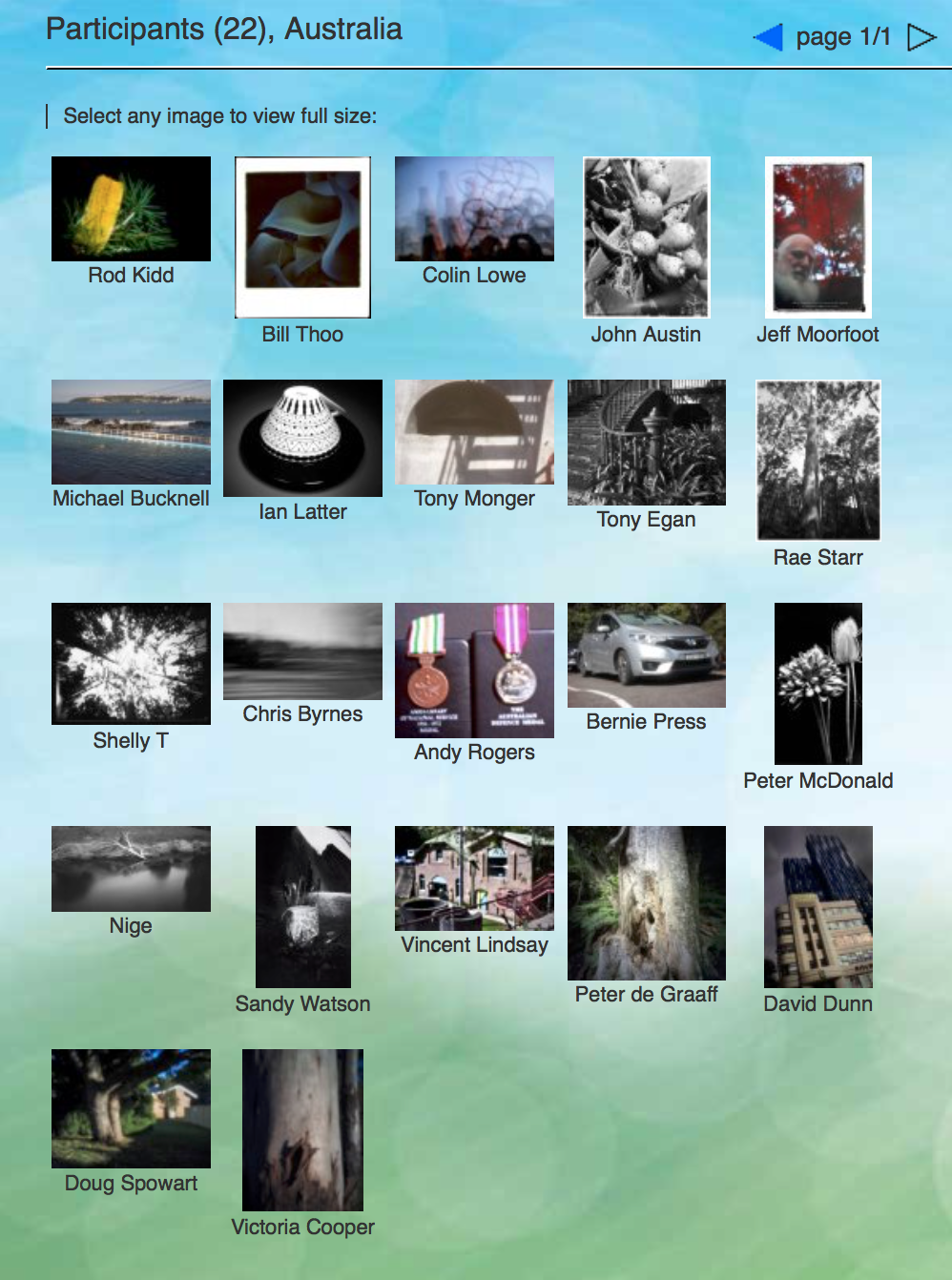
WPPD 2021 Australian submissions @ May 11, 2021
.
VICTORIA’s PINHOLE IMAGE: AFTERNOON WALK

Victoria Cooper’s Evening walk pinhole photo
ABOUT VICKY’S PINHOLE IMAGE:
We pass by these trees everyday… I decided to take pinhole photos of our walk as I enjoy the way they transform these everyday places into a kind of poem, not distinct nor descriptive just evocative.
DOUG’s PINHOLE IMAGE: TREE HOUSE
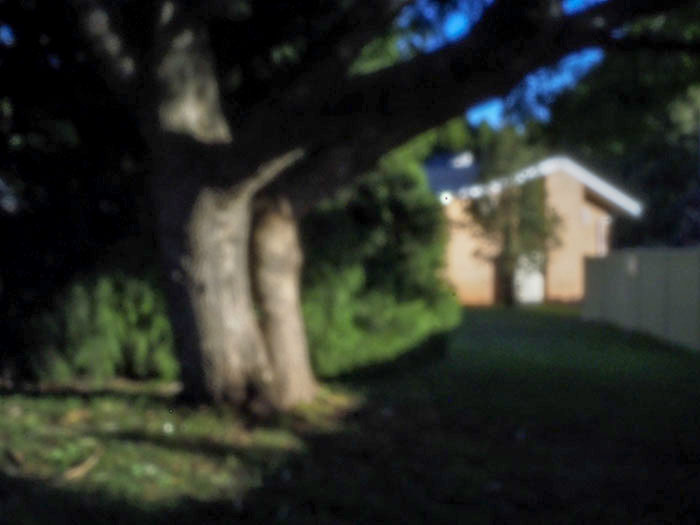
Tree House a pinhole image by Doug Spowart
ABOUT DOUG’S PINHOLE IMAGE:
I chose the late afternoon to go out and make images as the low light angle and the deep shadows add drama and mystery to pinholes made at this time.
Over recent years I have continued to choose a digital camera and aluminium pie dish with a pin prick in it. Wet darkrooms and film, although it suited the zone plates of landscape that I made are beyond my current means – perhaps next year…
.
OUR Digi-PINHOLE CAMERA

The Cooper+Spowart digi OLYMPUS PEN with pinhole …
This is a converted digital Olympus Pen, shared with my partner Doug Spowart. The pinhole is a pin pierced hole in aluminium which is inserted into a hole drilled into a body cap. It is a hand held exposure of 1/25th second at ISO 2000.
Visit the WWPD Site for details of other submissions: http://pinholeday.org/
.
Our Past WPPD images:
2020 Doug+Vicky https://wotwedid.com/2020/05/13/2020-worldwide-pinhole-day-26-april-our-images/
2019 Doug+Vicky https://wotwedid.com/2019/04/29/2019-worldwide-pinhole-day-28-april-our-images/
2018 Doug+Vicky https://wotwedid.com/2018/04/29/2018-worldwide-pinhole-day-29-april-our-images/
2016 Doug: http://www.pinholeday.org/index.php?id=1235
2016 Vicky: http://www.pinholeday.org/index.php?id=1540
2015 https://wotwedid.com/2015/05/04/april-26-worldwide-pinhole-day-our-contributions-for-2015/
2014 Vicky’s http://pinholeday.org/gallery/2014/index.php?id=1810&City=Toowoomba
2014 Doug’s http://pinholeday.org/gallery/2014/index.php?id=1811&City=Toowoomba
2013 https://wotwedid.com/2013/04/29/world-pinhole-photography-day-our-contribution/
2012 http://www.pinholeday.org/gallery/2012/index.php?id=1937&searchStr=spowart
2011 http://www.pinholeday.org/gallery/2011/index.php?id=924
HERE IS THE LINK to the 2011 pinhole video http://www.youtube.com/watch?v=Yk4vnbzTqOU
2010 http://www.pinholeday.org/gallery/2010/index.php?id=2464&Country=Australia&searchStr=spowart
2006 http://www.pinholeday.org/gallery/2006/index.php?id=1636&Country=Australia&searchStr=cooper
2004 Vicky http://www.pinholeday.org/gallery/2004/index.php?id=1553&Country=Australia&searchStr=cooper
2004 Doug http://www.pinholeday.org/gallery/2004/index.php?id=1552&Country=Australia&searchStr=spowart
2003 http://www.pinholeday.org/gallery/2003/index.php?id=615&Country=Australia&searchStr=spowart
2002 http://www.pinholeday.org/gallery/2002/index.php?id=826&Country=Australia&searchStr=spowart
.
.































